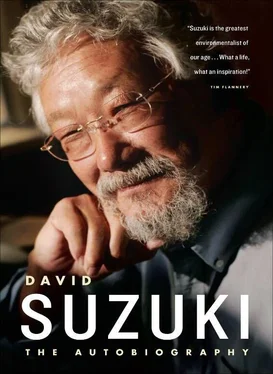
Sarika in an Inuit outfit I brought back from the Arctic
IN THE MEANTIME, AS our young family was growing, Mom was beginning to show signs of forgetfulness. She was constantly misplacing things — checks, clothing, letters — that might turn up weeks or months later or not at all. Dad and my sisters insisted she had Alzheimer's disease, but I denied it, because Mom exhibited no change in temperament. She did lose some of her inhibitions, however, and I took great delight in teasing her and telling off-color jokes, which would cause her to giggle.
By the early '80s, though, it was clear she was losing her short-term memory. She never became incontinent or failed to recognize her family, although Dad said she sometimes confused him with her brother.
As Mom lost interest in taking care of their finances, sewing, and cooking, Dad took on these responsibilities. He never complained, but I could see it was a heavy load, so I urged him to let me hire someone to help him. He resisted. “She devoted her life to me,” he said. “Now it's my turn to pay her back.” As Mom's needs increased, I saw a patient side of Dad — he was compassionate, considerate, and loving, and I admired him for it. But it was not easy. I once dropped in to my folks' place in the evening to find Mom in bed and Dad weeping with sadness and frustration about the condition she was in.
The day Sarika was born, I was in the hospital with Tara and Sarika when Dad arrived and asked anxiously, “Is Mom here?” She wasn't. My parents had come to the hospital to see the new baby, but as they were walking down the hall, Dad spotted an acquaintance and ducked in to see him, instructing Mom to “wait right here.” When he came out a few minutes later, she was gone. We began a frantic search for her, first running along all of the corridors of the hospital, then driving along streets in the neighborhood. Poor Tara had just given birth but was now worried sick about her mother-in-law. Tara's brother, Pieter, joined Dad and me as we drove along a series of grids looking for Mom, with no success.
Night fell, and we decided to wait at home and hope the police would find her. A call came at about 3:00 in the morning, and Dad and I raced down to the police station. A cab driver had picked her up and realized she was confused and needed help. Dad leaped out of the car when we got to the police station and raced up the stairs, where Mom was waiting at the top. He was crying as he hugged her. “What are you crying about? Let's go,” she said, as if nothing had happened. Her stockings had been worn right through, and she had been spotted in the Marpole neighborhood of Vancouver, miles away from the hospital, and trying to get into a blue Volkswagen van like the one Dad owned. Much later, the taxi had picked her up in a completely different part of the city.
On April 25, 1984, a month after they celebrated their fiftieth anniversary, Dad and Mom walked a few blocks to a local restaurant, had a meal together, and then went to a movie. As they were walking home, arm in arm, Mom had a massive heart attack and dropped to the sidewalk. Someone called a paramedic crew, who arrived within ten minutes and resuscitated her. They were doing their job, but the ten minutes of anoxia would have caused further damage to the brain already ravaged by dementia.
I was in Toronto at the time and was able to rush home and be with her for the week before she finally “died” on May 2. As Dad said, “She had a good death,” she didn't suffer, she was not incapacitated physically, and she had been with him right up to the heart attack. An autopsy revealed that she did indeed have the brain-tissue plaques characteristic of Alzheimer's.
SIX
HAIDA GWAII AND THE STEIN VALLEY
ALONG THE WEST COAST of Canada, extending south from the tip of the Alaska panhandle, is a chain of islands that some call Canada's Galápagos Islands. During the last glaciation, some ten thousand years ago, most of Canada was entombed in an ice sheet more than one mile thick. It is thought the ice might have encircled but not completely enveloped the islands, which became refuges for species that could move away from the ice. As ice formed, plants and animals moved up the mountainsides, which eventually became islands in a sea of ice and the repository of the survivors. Today many of their descendants are found nowhere else on the planet. This is Haida Gwaii, the land of the Haida people, which was named the Queen Charlotte Islands by more recent arrivals.
In the early 1970s, a combination of citizens, First Nations, and environmentalists on Haida Gwaii had become appalled at the logging practices on the islands and called for the British Columbia government to intervene and protect the land from the depradations. A symbol of the contentious areas was Windy Bay, a pristine watershed covering 12,350 acres of Lyell Island near South Moresby Island in the southern third of the archipelago.
In 1974, a group of citizens on Haida Gwaii demanded protection of critical parts of the islands from clear-cut logging. In response, the provincial government set up the Environment and Land Use Committee, made up of representatives of the various interest groups. In 1979, one of the committee's recommendations was not to log in Windy Bay. That was not an acceptable option to the forest company, which continued to press the B.C. government to allow logging. But Premier Bill Bennett could not ignore the environmentalists' increasing outspokenness or the public's greater awareness of environmental concerns. So in 1979 yet another group comprising a broad spectrum of environmentalists, forest company representatives, and other interest groups was set up as the South Moresby Resource Planning Team, chaired by Nick Gessler, an American expat who was running the Queen Charlotte Islands Museum.
I first heard about this controversy in 1982, when I received a handwritten note from the New Democratic Party member of Parliament representing the Skeena riding, which includes Haida Gwaii. In his note, Jim Fulton, the young social worker who had defeated the beautiful, charismatic incumbent and cabinet minister, Iona Campagnolo, wrote: “Soozook, you and The Nature of Things should do a program on Windy Bay.” At that point, I had no idea what the battles were about or even where Windy Bay was. But as I learned the issues, I could see it would be an important story and I suggested to Jim Murray, executive producer of The Nature of Things with David Suzuki , that we do a program on the fight over its fate. In fact, Dr. Bristol Foster, a wildlife biologist who had worked for the B.C. government for years before quitting in frustration, had already contacted Murray about the Windy Bay story.
Jim assigned the program to producer Nancy Archibald, and after the show's writer, Allan Bailey, had researched the background of the issue, Nancy and a crew flew to the islands to film. I followed days later to do some critical interviews and stand-ups on location in different parts of the archipelago. It was expensive to hire a helicopter and fly to the significant sites, so there wasn't a lot of time. Working frantically with Allan, I wrote, rewrote, and memorized the on-camera pieces as we flew by helicopter to different locations. Looking over those stand-ups today, I am gratified that they still resonate with relevance. I began the report this way:
The vast forests of Canada are more than just a potential source of revenue: they're part of the spiritual mystique of the country. I'm on Windy Bay in the Queen Charlotte Islands off the coast of British Columbia, and this virgin forest began its existence over eight thousand years ago. Many of these trees were already mature adults long before Christopher Columbus discovered America. It was here that the Haida Indians hunted and fished. They used these trees to build their dugout canoes and their longhouses. It was these trees that inspired Emily Carr to paint some of her most haunting pictures. Having existed for thousands of years, this forest could disappear in a matter of months through logging. Tonight we face a special issue that could affect all Canadians and asks us to redefine our notion of progress.
Читать дальше



![David Jagusson - Devot & Anal [Hardcore BDSM]](/books/485905/david-jagusson-devot-anal-hardcore-bdsm-thumb.webp)









